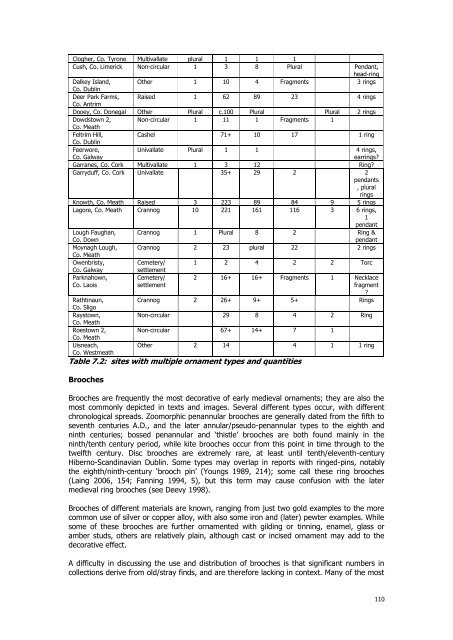EMAP_2012_Report_6_1.pdf (7.3 MB) - The Heritage Council
EMAP_2012_Report_6_1.pdf (7.3 MB) - The Heritage Council
EMAP_2012_Report_6_1.pdf (7.3 MB) - The Heritage Council
You also want an ePaper? Increase the reach of your titles
YUMPU automatically turns print PDFs into web optimized ePapers that Google loves.
Clogher, Co. Tyrone Multivallate plural 1 1 1<br />
Cush, Co. Limerick Non-circular 1 3 8 Plural Pendant,<br />
head-ring<br />
Dalkey Island, Other 1 10 4 Fragments 3 rings<br />
Co. Dublin<br />
Deer Park Farms, Raised 1 62 89 23 4 rings<br />
Co. Antrim<br />
Dooey, Co. Donegal Other Plural c.100 Plural Plural 2 rings<br />
Dowdstown 2, Non-circular 1 11 1 Fragments 1<br />
Co. Meath<br />
Feltrim Hill,<br />
Cashel 71+ 10 17 1 ring<br />
Co. Dublin<br />
Feerwore,<br />
Co. Galway<br />
Univallate Plural 1 1 4 rings,<br />
earrings?<br />
Garranes, Co. Cork Multivallate 1 3 12 Ring?<br />
Garryduff, Co. Cork Univallate 35+ 29 2 2<br />
pendants<br />
, plural<br />
rings<br />
Knowth, Co. Meath Raised 3 223 89 84 9 5 rings<br />
Lagore, Co. Meath Crannog 10 221 161 116 3 6 rings,<br />
1<br />
pendant<br />
Lough Faughan,<br />
Co. Down<br />
Crannog 1 Plural 8 2 Ring &<br />
pendant<br />
Moynagh Lough, Crannog 2 23 plural 22 2 rings<br />
Co. Meath<br />
Owenbristy,<br />
Co. Galway<br />
Cemetery/<br />
settlement<br />
1 2 4 2 2 Torc<br />
Parknahown,<br />
Co. Laois<br />
Rathtinaun,<br />
Co. Sligo<br />
Raystown,<br />
Co. Meath<br />
Roestown 2,<br />
Co. Meath<br />
Uisneach,<br />
Co. Westmeath<br />
Cemetery/<br />
settlement<br />
2 16+ 16+ Fragments 1 Necklace<br />
fragment<br />
?<br />
Crannog 2 26+ 9+ 5+ Rings<br />
Non-circular 29 8 4 2 Ring<br />
Non-circular 67+ 14+ 7 1<br />
Other 2 14 4 1 1 ring<br />
Table 7.2: sites with multiple ornament types and quantities<br />
Brooches<br />
Brooches are frequently the most decorative of early medieval ornaments; they are also the<br />
most commonly depicted in texts and images. Several different types occur, with different<br />
chronological spreads. Zoomorphic penannular brooches are generally dated from the fifth to<br />
seventh centuries A.D., and the later annular/pseudo-penannular types to the eighth and<br />
ninth centuries; bossed penannular and ‘thistle’ brooches are both found mainly in the<br />
ninth/tenth century period, while kite brooches occur from this point in time through to the<br />
twelfth century. Disc brooches are extremely rare, at least until tenth/eleventh-century<br />
Hiberno-Scandinavian Dublin. Some types may overlap in reports with ringed-pins, notably<br />
the eighth/ninth-century ‘brooch pin’ (Youngs 1989, 214); some call these ring brooches<br />
(Laing 2006, 154; Fanning 1994, 5), but this term may cause confusion with the later<br />
medieval ring brooches (see Deevy 1998).<br />
Brooches of different materials are known, ranging from just two gold examples to the more<br />
common use of silver or copper alloy, with also some iron and (later) pewter examples. While<br />
some of these brooches are further ornamented with gilding or tinning, enamel, glass or<br />
amber studs, others are relatively plain, although cast or incised ornament may add to the<br />
decorative effect.<br />
A difficulty in discussing the use and distribution of brooches is that significant numbers in<br />
collections derive from old/stray finds, and are therefore lacking in context. Many of the most<br />
110
















